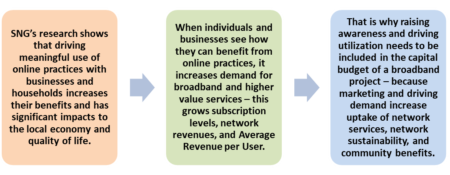Budgeting for Broadband Network Sustainability
Financing Digital Transformation to Drive Broadband Network Uptake and Local Economic Growth
In the past, efforts to market broadband services have often been an afterthought to the network build, or left to the private sector as part of their business development. If you are building-out a network to unserved and underserved areas, where incumbent service providers have not seen enough of a business case to invest, you must have adequate resources for marketing and community engagement to raise awareness, drive demand, and maximize community impacts!

Whatever digital infrastructure investment is being made – whether retail network, open access network, or smart community initiative, you must assess and drive demand and be able to tell the story about how it benefited the community. Call it Marketing, Driving Demand and Performance Measurement and build it into the capital budget for the network. This ensures you have the resources for ongoing efforts to be effective with market research and community engagement. This cannot be underestimated as network sustainability and overcoming the challenges faced by local network investments (growing market demand where there has not been enough to justify a private sector business case for broadband investment, overcoming resistance by incumbent service providers, taxpayer resistance and political risk, etc) must be addressed for success.
Marketing and community engagement efforts are most important in the early stages of a digital infrastructure or transformation initiative when operating budgets are stretched thin, or not available. Include in the capital financing of the network at least 10% for marketing, community engagement, and performance reporting – this will drive digital transformation in the community, which in turn drives service sustainability, local economic growth, and community benefits. There is urgency to providing local residents and businesses the broadband they need because the cost to the community will be greater if they leave, or are not able to be competitive.
“You can put fiber in the ground, hang it in the air, and give them all the capacity they need, but people just don’t know what to do with it. You need to show and teach people what they can do with this capacity so they can grow their business.”
Michael Foor
Vice President, Market and Member Services for North Georgia Network
With market analytics and data on community impacts, elected officials, economic development professionals, and community stakeholders can:
- Identify evolving community needs and digital divide gaps
- Implement digital infrastructure and smart community services assessed to have the biggest impact on the community – avoiding pitfalls and making sure this is going to work
- Show community return on investment (ROI) in terms of business retention and growth, GDP and tax base impacts, quality of life benefits, etc.
Below is an example of a high-level budget. A detailed actual budget for your community can be developed with SNG’s data-driven analytics that is comprehensive in assessing the resources needed to reach network demand and sustainability goals, thereby shortening the path to community benefits and economic impacts.
Example – High-level Budget for Digital Infrastructure and Transformation Investment
| Investment Category | Amount |
|---|---|
| Network capital investment (includes engineering, design, consulting, network infrastructure, etc.) | $4,000,000 |
| Growing Broadband Demand and the Local Economy through marketing, driving demand, community engagement, and performance measurement (to be capitalized in two line items as below): | |
1) Marketing and Analytics, Driving Sustainability, and Performance Reporting to engage the community in digital transformation. Strategies and tactics can be customized using broadband market analytics and performance data are critical to:
|
$200,000 ( 5% of capital investment |
2) Matching grants to incentivize implementation of new technology and online business applications by local businesses, schools, health facilities, anchor institutions, etc. This is a local economic stimulus that accelerates digital transformation and grows demand for more sophisticated services because it:
|
$800,000 ( 20% of capital investment |
| Total financing of network and programming to more quickly achieve a sustainable network, local economic growth, and community benefits | $5,000,000 |
Take a data-driven approach to assess and drive demand and be able to tell the story about how digital infrastructure and transformation benefited the community. Develop marketing strategies and tactics that identify key user and community groups. Personalize to individual businesses and households the ROI of online practices. This is an ongoing process and key to driving demand. It is also necessary for achieving network sustainability and realizing community benefits that include new jobs, local business growth, GDP and tax base increases, etc.
